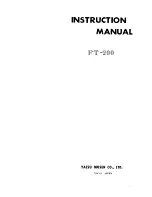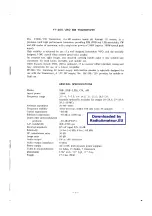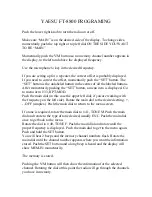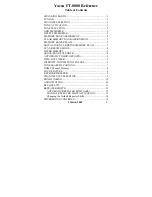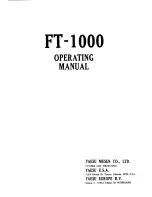
Revision 1.0
SMV800 Modbus User's Guide
Page 31
Engineering Units
The Process Temperature Config tab displays the Lower Range Value (LRV), Lower Range Limit
(LRL), Upper Range Value (URV) and Upper Range Limit (URL) for Process temperature in the unit
of measure selected in the Engineering Units field.
Selecting PT Engineering Units
Select one of the preprogrammed engineering units in
Table 2-5
for display of the PT measurements,
depending upon output characterization configuration.
Also select one of the preprogrammed engineering units for display of the cold junction temperature
readings (CJT Units field). This selection is independent of the other sensor measurements. See Cold
Junction Compensation below.
Table 2-5: Pre-programmed Engineering Units for PT
Engineering Unit
Meaning
C
d
Degrees Celsius or Centigrade
F
Degrees Fahrenheit
K
Kelvin
R
Degrees Rankine
Cold Junction Compensation
If a thermocouple is used for process temperature input, you must select if the cold junction (CJ)
compensation will be supplied internally by the transmitter or externally from a user-supplied
isothermal block.
Specify source of cold junction temperature compensation.
•
Internal
•
Fixed - Must also key in value of cold junction temperature for reference.
Background
Every thermocouple requires a hot junction and a cold junction for operation. The hot junction is
located at the point of process measurement and the cold junction is in the transmitter (internal) or
at an external location selected by the user. The transmitter bases its range measurement on the
difference of the two junctions. The internal or external temperature sensitive resistor compensates
for changes in ambient temperature that would otherwise have the same effect as a change in
process temperature.
If you configure CJ source as fixed, you must tell the transmitter what cold junction temperature to
reference by typing in the temperature as a configuration value. For internal cold junction
configuration, the transmitter measures the cold junction temperature internally.
You can have the transmitter provide a linear output which is linearized to temperature for PT
input, or a nonlinear output which is proportional to resistance for an RTD input or volt input for
T/C input. Also, if you do switch from linear to non-linearized or vice versa, be sure you verify the
LRV and URV settings after you enter the configuration data.
Содержание SMV800
Страница 82: ...Page 70 SMV800 Modbus User s Guide Revision 1 0 ...
Страница 86: ...Page 74 SMV800 Modbus User s Guide Revision 1 0 Use method Reset Tamper Counter to reset the tamper attempts ...
Страница 95: ...Revision 1 0 SMV800 Modbus User s Guide Page 83 2 5 4 Review ...
Страница 98: ...Page 86 SMV800 Modbus User s Guide Revision 1 0 2 7 SMV 800 Modbus Host Menu tree Device Setup Menu ...
Страница 99: ...Revision 1 0 SMV800 Modbus User s Guide Page 87 ...
Страница 100: ...Page 88 SMV800 Modbus User s Guide Revision 1 0 ...
Страница 101: ...Revision 1 0 SMV800 Modbus User s Guide Page 89 ...
Страница 102: ...Page 90 SMV800 Modbus User s Guide Revision 1 0 ...
Страница 103: ...Revision 1 0 SMV800 Modbus User s Guide Page 91 Maintenance Menu ...
Страница 104: ...Page 92 SMV800 Modbus User s Guide Revision 1 0 2 7 1 Advanced Diagnotics Menu ...
Страница 105: ...Revision 1 0 SMV800 Modbus User s Guide Page 93 2 7 2 Monitoring Menu ...
Страница 112: ...Page 100 SMV800 Modbus User s Guide Revision 1 0 ...
Страница 116: ......































